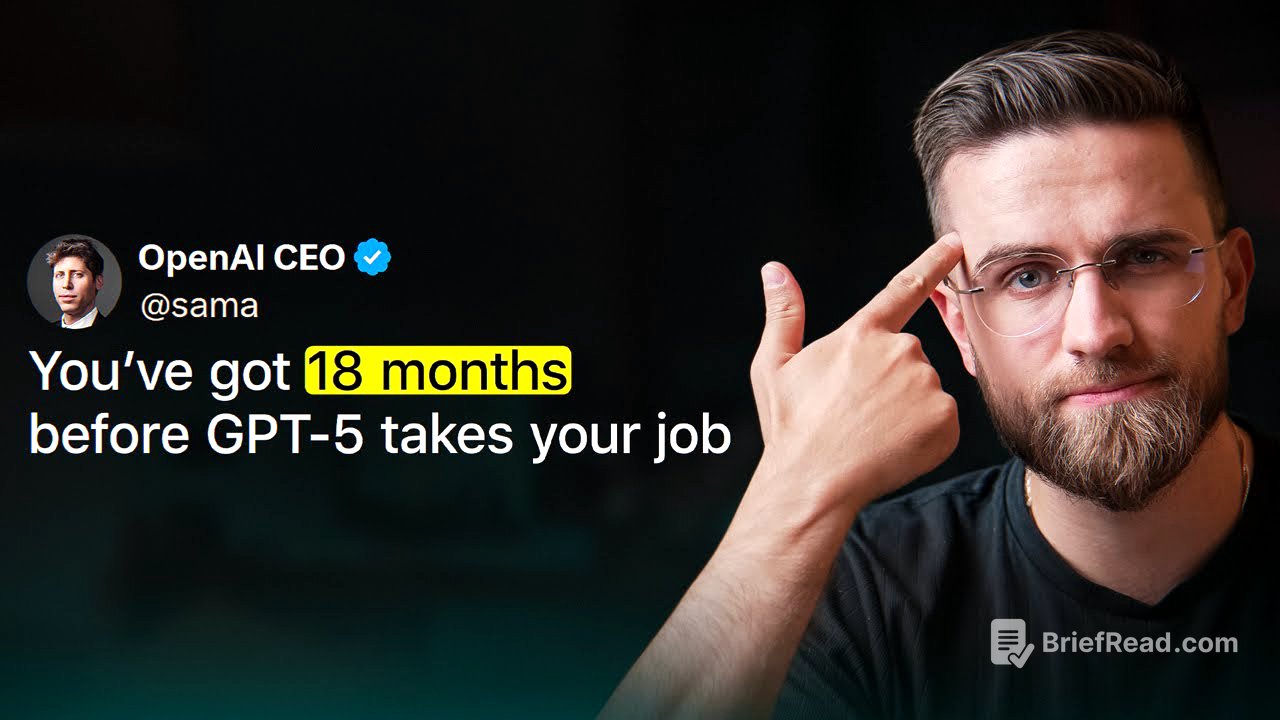TLDR;
This video discusses the impact of AI on various job sectors by 2026, highlighting potential job losses and transformations. It emphasizes the importance of adapting to AI tools to remain relevant and valuable in the workforce.
- AI is expected to automate significant portions of many jobs, including white-collar positions.
- The key to surviving the AI revolution is to learn how to work with AI tools and focus on uniquely human skills.
- The video covers specific job roles like clerical staff, accountants, customer support, content creators, designers, legal professionals, and coders, explaining how AI will change their functions.
Intro [0:00]
The video introduces the idea that AI will significantly impact the job market by 2026, with about 80% of US workers potentially seeing at least 10% of their job tasks automated. It notes that nearly one in five people might have half of their duties taken over by machines. The discussion spans beyond factory and warehouse jobs to include white-collar jobs in finance, law, and media, as well as some creative roles. The video aims to guide viewers through nine types of jobs that may disappear or drastically change due to AI.
Job 1 [1:12]
The first job category discussed is clerical roles, including data entry clerks and office administrators. AI excels at repetitive tasks such as data input, scheduling meetings, organizing files, and sending automated emails. Software can input data and scan documents faster and more accurately than humans, and AI-powered calendar scheduling assistants can set up meetings automatically. The nature of these jobs is likely to change, with employees overseeing AI systems and handling complex situations that AI cannot manage. Acquiring tech skills and learning to work with AI tools can transform former office assistants into automation specialists, turning a potential threat into a career boost.
Job 2 [3:20]
The video addresses the impact of AI on bookkeepers and accountants, noting that software has already automated many routine tasks. AI can scan receipts and invoices, categorize transactions, reconcile accounts, generate financial reports, and flag unusual transactions. AI auditors are also emerging, capable of detecting fraud by recognizing patterns that humans might miss. While AI automates routine tasks, the role of human accountants is shifting towards analysis and strategy. Mastering AI tools can make accountants more efficient and valuable, allowing them to focus on creative problem-solving.
Job 3 [6:35]
The discussion shifts to customer support, where AI chatbots are increasingly handling common customer inquiries. Companies are heavily investing in AI-driven customer service to answer frequently asked questions and provide 24/7 support. AI chatbots can handle a significant percentage of support tickets, passing complex issues to human agents. The role of human support representatives is evolving to handle difficult customers, complex problems, and situations requiring empathy. Customer service is becoming AI-driven, with humans acting as specialists for higher-level support.
Job 4 [9:03]
The video explores AI's impact on content creation, including copywriters, bloggers, YouTubers, and marketers. AI tools can generate blog post drafts, catchy slogans, product descriptions, images, and graphics quickly. However, while AI can produce large amounts of content, it may lack genuine spark and insight. The value of human creators is shifting towards personal voice, unique perspectives, storytelling, and connecting ideas in ways AI cannot. Content creators can use AI for brainstorming, generating drafts, and creating visuals, while focusing on polishing, fact-checking, and adding unique elements.
Job 5 [11:47]
The discussion turns to designers, including graphic designers, illustrators, and UI/UX designers. AI-generated images are becoming increasingly prevalent, with tools like Midjourney, Dolly, and Stable Diffusion creating artwork from text prompts. While these tools can supercharge the creative process and prototype ideas faster, they also raise concerns about clients opting for AI-generated graphics over professional designers. The best designers solve problems and tell stories visually, which AI cannot fully replicate. Designers can use AI to generate initial images and refine them, focusing on creative direction and important details.
Job 6 [15:12]
The video examines the legal field, focusing on paralegals and junior lawyers. AI tools can assist with tasks such as scanning documents, reviewing evidence, and drafting contracts and legal briefs. AI models have even passed the bar exam, signaling a significant shift in the industry. For paralegals, AI can quickly pull up case precedents and summarize them. Law firms are using AI for contract review, flagging risky terms and errors. While AI handles much of the heavy lifting, human lawyers are still needed for verification, argumentation, and nuanced reasoning.
Job 7 [18:07]
The final job category discussed is coders and software developers. AI tools like GitHub Copilot and ChatGBT can write chunks of code, find bugs, and suggest improvements. These tools significantly boost productivity, allowing developers to build features faster. However, AI does not truly understand the code it writes and may produce insecure or suboptimal code. Human developers are still needed to review, test, design overall architecture, and determine what needs to be built. The role of the developer is evolving to focus on orchestrating, problem-solving, integrating different pieces, and ensuring quality.
What's next? [21:27]
The video concludes by emphasizing that change is constant and that adapting to AI is crucial for finding new opportunities. It encourages viewers to stay curious, keep learning, and find ways to use AI as an assistant. AI is a powerful tool that still needs direction, creativity, and oversight from humans. The video encourages viewers to share their thoughts and concerns about the rise of AI in their fields and to connect with others in the AI master community.









